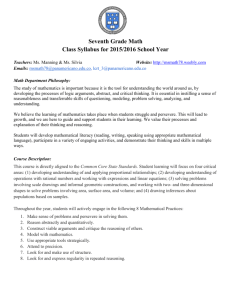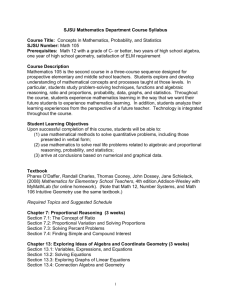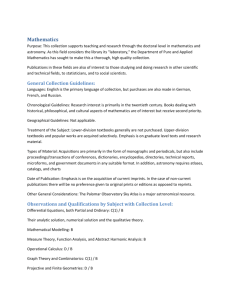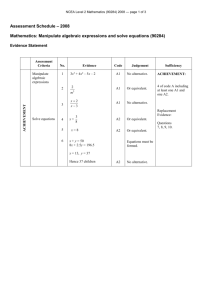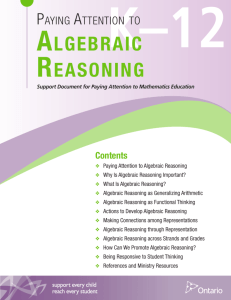Quantitative Reasoning
advertisement
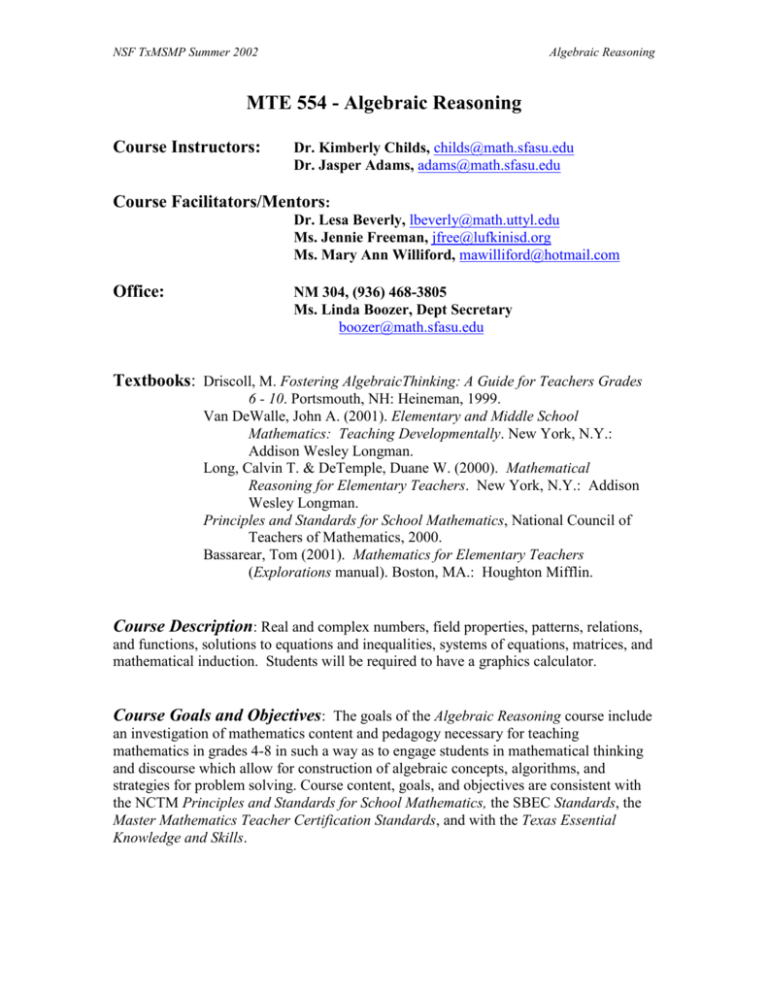
NSF TxMSMP Summer 2002 Algebraic Reasoning MTE 554 - Algebraic Reasoning Course Instructors: Dr. Kimberly Childs, childs@math.sfasu.edu Dr. Jasper Adams, adams@math.sfasu.edu Course Facilitators/Mentors: Dr. Lesa Beverly, lbeverly@math.uttyl.edu Ms. Jennie Freeman, jfree@lufkinisd.org Ms. Mary Ann Williford, mawilliford@hotmail.com Office: NM 304, (936) 468-3805 Ms. Linda Boozer, Dept Secretary boozer@math.sfasu.edu Textbooks: Driscoll, M. Fostering AlgebraicThinking: A Guide for Teachers Grades 6 - 10. Portsmouth, NH: Heineman, 1999. Van DeWalle, John A. (2001). Elementary and Middle School Mathematics: Teaching Developmentally. New York, N.Y.: Addison Wesley Longman. Long, Calvin T. & DeTemple, Duane W. (2000). Mathematical Reasoning for Elementary Teachers. New York, N.Y.: Addison Wesley Longman. Principles and Standards for School Mathematics, National Council of Teachers of Mathematics, 2000. Bassarear, Tom (2001). Mathematics for Elementary Teachers (Explorations manual). Boston, MA.: Houghton Mifflin. Course Description: Real and complex numbers, field properties, patterns, relations, and functions, solutions to equations and inequalities, systems of equations, matrices, and mathematical induction. Students will be required to have a graphics calculator. Course Goals and Objectives: The goals of the Algebraic Reasoning course include an investigation of mathematics content and pedagogy necessary for teaching mathematics in grades 4-8 in such a way as to engage students in mathematical thinking and discourse which allow for construction of algebraic concepts, algorithms, and strategies for problem solving. Course content, goals, and objectives are consistent with the NCTM Principles and Standards for School Mathematics, the SBEC Standards, the Master Mathematics Teacher Certification Standards, and with the Texas Essential Knowledge and Skills. NSF TxMSMP Summer 2002 Algebraic Reasoning Specific goals and objectives include: To use algebraic concepts and reasoning to investigate patterns, make generalizations, formulate mathematical models, make predictions, and validate results; To use properties, graphs, and applications of relations and functions to analyze, model, and solve problems; To understand the relationships among variables, expressions, equations, inequalities, and systems in order to analyze, model, and solve problems; To make connections among geometric, graphic, numeric, and symbolic representations of functions and relations; To model, construct, and solve algebraic problems within and outside of mathematics; To know how patterns, relations, functions, algebraic reasoning, and analysis are developmental and connected between and across all grade levels. Course Evaluation Activities (30%) Assigned work includes daily assignments, short quizzes, class participation in various activities and discussions, and written responses on various assigned readings. Tests (50%) Two major tests covering material discussed in weeks one and two. Performance Assessment (20%) The performance assessment will be based on course content and pedagogy. It will measure how well you have met course and MMT objectives . Course Syllabus (Class: June 10 - 21) REVIEW OF ALGEBRA The Structure of the Real Number System Properties of Real Numbers and the Basic Rules of Algebra Radical and Rational Exponents/Properties of Exponents Polynomials and Special Products Factoring Rational Expressions The Complex Number System Properties of Complex Numbers Deductive and inductive reasoning NSF TxMSMP Summer 2002 Algebraic Reasoning FUNCTIONS AND GRAPHS Representing Problems with Equations Patterns, Tables, Equations, and Graphs The Concept of Relations and Functions Types of Functions Relations, Functions and Inverses LINEAR AND NON-LINEAR FUNCTIONS Intuition for Slope: Rate of Change Linear and Quadratic Equations, Inequalities, and Functions Developing the Equation of the Line Exponential Functions Systems of Equations/Matrices Theory of Polynomial Functions, including Synthetic Division, Remainder Theorem, Factor Theorem, and Fundamental Theorem of Algebra ALGEBRAIC CONCEPTS IN THE ELEMENTARY CURRICULUM Trace algebraic thinking through the 4 - 8 grade level curriculum strands, using the Texas Essential Knowledge and Skills (TEKS) as a reference
